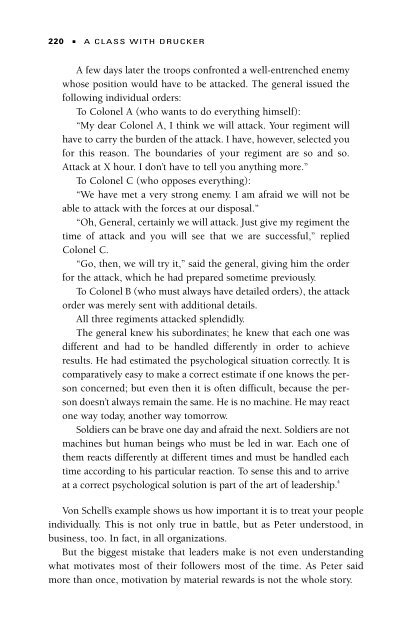A Class with Drucker - Headway | Work on yourself
A Class with Drucker - Headway | Work on yourself
A Class with Drucker - Headway | Work on yourself
Create successful ePaper yourself
Turn your PDF publications into a flip-book with our unique Google optimized e-Paper software.
220 ■ A CLASS WITH DRUCKER<br />
A few days later the troops c<strong>on</strong>fr<strong>on</strong>ted a well-entrenched enemy<br />
whose positi<strong>on</strong> would have to be attacked. The general issued the<br />
following individual orders:<br />
To Col<strong>on</strong>el A (who wants to do everything himself):<br />
“My dear Col<strong>on</strong>el A, I think we will attack. Your regiment will<br />
have to carry the burden of the attack. I have, however, selected you<br />
for this reas<strong>on</strong>. The boundaries of your regiment are so and so.<br />
Attack at X hour. I d<strong>on</strong>’t have to tell you anything more.”<br />
To Col<strong>on</strong>el C (who opposes everything):<br />
“We have met a very str<strong>on</strong>g enemy. I am afraid we will not be<br />
able to attack <str<strong>on</strong>g>with</str<strong>on</strong>g> the forces at our disposal.”<br />
“Oh, General, certainly we will attack. Just give my regiment the<br />
time of attack and you will see that we are successful,” replied<br />
Col<strong>on</strong>el C.<br />
“Go, then, we will try it,” said the general, giving him the order<br />
for the attack, which he had prepared sometime previously.<br />
To Col<strong>on</strong>el B (who must always have detailed orders), the attack<br />
order was merely sent <str<strong>on</strong>g>with</str<strong>on</strong>g> additi<strong>on</strong>al details.<br />
All three regiments attacked splendidly.<br />
The general knew his subordinates; he knew that each <strong>on</strong>e was<br />
different and had to be handled differently in order to achieve<br />
results. He had estimated the psychological situati<strong>on</strong> correctly. It is<br />
comparatively easy to make a correct estimate if <strong>on</strong>e knows the pers<strong>on</strong><br />
c<strong>on</strong>cerned; but even then it is often difficult, because the pers<strong>on</strong><br />
doesn’t always remain the same. He is no machine. He may react<br />
<strong>on</strong>e way today, another way tomorrow.<br />
Soldiers can be brave <strong>on</strong>e day and afraid the next. Soldiers are not<br />
machines but human beings who must be led in war. Each <strong>on</strong>e of<br />
them reacts differently at different times and must be handled each<br />
time according to his particular reacti<strong>on</strong>. To sense this and to arrive<br />
at a correct psychological soluti<strong>on</strong> is part of the art of leadership. 4<br />
V<strong>on</strong> Schell’s example shows us how important it is to treat your people<br />
individually. This is not <strong>on</strong>ly true in battle, but as Peter understood, in<br />
business, too. In fact, in all organizati<strong>on</strong>s.<br />
But the biggest mistake that leaders make is not even understanding<br />
what motivates most of their followers most of the time. As Peter said<br />
more than <strong>on</strong>ce, motivati<strong>on</strong> by material rewards is not the whole story.


